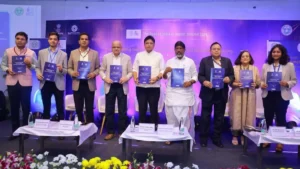Amazon Web Services (AWS) has revealed plans to invest $12.7 billion into cloud infrastructure in India by 2030, aiming to meet the increasing demand for cloud services in the country. The investment is projected to contribute $23.3 billion to India’s economy over the same period, building upon AWS’s previous investment of $3.7 billion between 2016 and 2022. With this latest commitment, AWS’s total investment in India will reach $16.4 billion by 2030. The company is focused on fostering positive social and economic impact in India, as demonstrated by its efforts in digital skills training and renewable energy projects.
Cloud Infrastructure Investment and Economic Impact
AWS’s investment in data center infrastructure in India is expected to generate an estimated 131,700 full-time equivalent jobs in Indian businesses each year. These positions encompass a wide range of roles, including construction, facility maintenance, engineering, and telecommunications, forming an integral part of India’s data center supply chain. AWS currently operates two data center infrastructure regions in India, located in Mumbai and Hyderabad. Through its substantial investments, AWS has already made a significant contribution of over $4.6 billion to the Indian economy between 2016 and 2022, supporting approximately 39,500 full-time equivalent jobs annually.
Buy Prime Test Series for all Banking, SSC, Insurance & other exams
AWS’s Commitment to India’s Digital Powerhouse Status
Puneet Chandok, President of Commercial Business at AWS India and South Asia, reiterated AWS’s commitment to driving positive social and economic change in India. Besides expanding cloud infrastructure and facilitating the digital transformation of local customers and partners, AWS has been instrumental in upskilling over four million individuals in India with cloud skills since 2017. Moreover, the company has invested in six utility-scale renewable energy projects to achieve its global 100% renewable energy goal by 2025. By further investing in India, AWS aims to amplify its positive impact, supporting India’s journey towards becoming a global digital powerhouse.
Cloud Adoption Benefits and Cost Reduction
The migration of businesses to cloud systems provided by specialized companies such as Oracle, AWS, and SAP offers several advantages over maintaining an on-premises infrastructure. Industry experts note that utilizing cloud services is more cost-effective, as businesses only pay for the specific services or resources they utilize over time. By avoiding the need to build and manage their own servers, hardware, and security networks, organizations can significantly reduce their overall cost of ownership. This approach aligns with the growing trend of businesses embracing cloud technology for enhanced efficiency and scalability.
AWS’s Rapid Growth and Skills Development Initiatives
AWS has experienced substantial growth in its business, particularly in the post-Covid era. In the first quarter of the year, the company’s revenue reached $21.4 billion, marking an annual increase of over 16%. Recognizing the importance of skilled professionals in driving cloud adoption, AWS has been actively training individuals in cloud skills in India since 2017, reaching a milestone of over four million trained individuals. In February, the company also launched an initiative aimed at assisting unemployed and underemployed IT professionals in India, enabling them to enhance their skills and transition to mid-level cloud careers.
Environmental Impact and Energy Efficiency
The shift from on-premises data centers to cloud infrastructure offers environmental benefits as well. According to 451 Research, a division of S&P Global Market Intelligence, Indian companies and public sector organizations that migrate their computing workloads to the cloud can reduce their energy consumption and associated carbon footprint by nearly 80%.




 Which is the Largest Railway Station of ...
Which is the Largest Railway Station of ...
 IndiGo Flight Disruptions Explained: FDT...
IndiGo Flight Disruptions Explained: FDT...
 NITI Aayog & IBM Unveil Roadmap to M...
NITI Aayog & IBM Unveil Roadmap to M...







